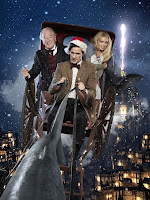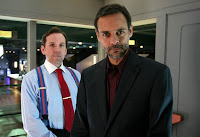Stuff was in no fit state to pass comment on the most recent ‘Dr Who’ Christmas Special ‘A Christmas Carol’ because Christmas itself was a bit of a write-off due to a bout of genuine, 100%, out for the count flu which meant the entire festive season passed by pretty much unnoticed. Fortunately the BBC have now issued said adventure on a shiny new DVD release which gives me the perfect excuse to watch it again and to finally marshall my thoughts on this most seasonable (yet) of ‘Dr Who’ adventures.
‘A Christmas Carol’ is, in many ways, the perfect example of showrunner/head writer Steven Moffat’s apparent perception of ‘Dr Who’ as a modern-day fairytale. Season five showed us the way the series was going. Moffat eased ‘Dr Who’ away from the urgent urban backdrop favoured by Russell T Davies and set it down in the quaint world of made-up English villages, legends of girls and boys who waited, ancient cosmic traps and deadly dreamscapes. Apart from the pre-title sequence of ‘The Eleventh Hour’ London barely got a look in (and neither did contemporary Earth, come to that). In retrospect, along with all the other changes Moffat brought to the series (new Doctor, new companions, new music, new titles, new logo, new TARDIS inside and out, new sonic and, most controversially, new fat Daleks) maybe the style of the show changed a bit too drastically. It’s all down to personal taste, of course. Many fans welcomed this routine to what they saw as a more traditional style of ‘Dr Who’ with Matt Smith playing a version of the character far more reminiscent of some of his earlier incarnations than either Christopher Eccleston or David Tennant, both of whom played the Doctor as a Modern Man, a Time lord of our times. Under Moffat we have a Doctor very much in the mould of Patrick Troughton, bumbling and vague and yet authoritative and wearing a ‘costume’ rather than the ‘clothes’ sported by his immediate predecessors. Other fans – casual fans as well as the hardcore – felt more at home with Davies’ domesticated Doctor, returning to Earth every now and again to visit his companion’s relatives, and racing around the streets tangling with soldiers and tussling with politicians. But ‘Dr Who’ should never rest on its laurels, it should always strive to change and stay one step ahead of the game (and its audience) and whilst Stuff sort of misses the easy edge Davies gave his series, Moffat’s episodes, despite obvious funding issues last year, have their own charm and appeal which, if reports on the work-in-progress forthcoming sixth season are any indication, look as if they may herald a pleasing combination of the old and the new.

So to ‘A Christmas Carol’ and here, more than anywhere else, we can see the difference between Davies and Moffat – at least in the way they approach the thorny subject of the big Christmas night episode. Designed to attract as many people as possible on the laziest TV night of the year, both men clearly understand that ‘Dr Who’ has to tell a straight-forward story, unencumbered by the weight of the show’s fifty-year mythology, because many of those watching may not be regular viewers, they may be tuning in because they’re just too bloated to turn over to watch ‘Emmerdale’. Davies rose to the Christmas challenge by writing big epic adventures – a giant spider-queen descending from the stars to awaken her long-dormant arachnid offspring, skull-headed aliens invading Earth in their rock-shaped spaceship, an alien facsimile of the Titanic sabotaged and plunging towards the Earth, a giant walking Cyberfactory stomping around Victorian London. Big bold stories, full of extraordinary visual images and mad ideas; not the stuff hand-wringing fans can tolerate or take seriously but ideal fare for a casual audience who just want to be thrilled on Christmas night. Moffat’s stance is slightly different; he goes all romantic. ‘A Christmas Carol’ is one of the oddest ‘Dr Who’ adventures in the show’s long and twisty history (its twistory, if you will...and you probably won’t). With the Doctor#s newly-wedded chums Amy and Rory honeymooning on a space-cruiser plunging to destruction, the Doctor battles not cyborgs or robots or space-lizards – but he battles against Time to change the heart of a lonely and bitter old man, the one man who can save his friends and the 4,000 other people on board the space liner.

Curiously, ‘A Christmas Carol’ is an episode almost entirely without peril of jeopardy. Yes, the Doctor encounters a giant shark but it’s an encounter that’s over and done with in thirty seconds and we never really think the Doctor’s in danger. Only the irritating Amy (absent from much of the episode) and her cliched bumbling, brow-breaten husband Rory are in danger and we never really believe for a moment there’s not going to be a last minute rescue. Moffat occupies the sixty minutes in between the title sequences by fashioning a charming, if slight, story which takes its cue from Dickens but is full of all those time travel paradoxes and smart-mouth dialogue which the writer seems obsessed with. It all makes for a schizophrenic episode which is by turns frustrating and yet heart-warming. I still have issues with Moffat’s writing now he’s the Boss man of ‘Who’; he’s cast a truly astonishing actor in Matt Smith – watch him, just watch him, the way he acts with his face, his body, he’s always acting, he’s always inhabiting this character – but he doesn’t really seem to know what do with him other than get him to spurt silly comic catchphrases: “[insert item of clothing here) is cool!” or else ramble incoherently and insensibly. Matt’s not been given his defining episode yet, the episode where he really makes his mark, the episode where the audience finally sits up and goes “Wow, he’s really good!” He shines and glows and excels all the way through ‘A Christmas Carol’ but it’s hard not to feel that all the hard work done by his predecessors in making the Doctor real and believable is being chipped away by jokey references to Frank Sinatra and wedding to Marilyn Monroe. Maybe it’s the way Moffat wants it, but the Doctor’s becoming a fantasy figure again, and too much of his dialogue has become trite and silly, vehicles for gags-for-gags sake rather than to establish a firm character or any motivation for the latest Doctor.

Ongoing series quibbles aside then, and taken at its own face value, ‘A Christmas Carol’ is an accomplished and impressive piece of TV. Yes, the story is something and nothing but it looks absolutely stunning, banishing any lingering memories of some of last year’s cash-strapped adventures (invisible aliens, pensioners on zimmer frames, lazily-reused monster costumes for the finale) with some astonishingly sumptuous sets from the show’s new resident set designer Michael Pickwoad. Guest stars Michael Gambon and Katherine Jenkins are good value too. Gambon’s miserly Kazran Sardick is mean and cruel but we never see him as evil and he’s never really painted as the ‘bad guy’; once the Doctor sets off on his mission to change the man so he can save his friends (a long-winded way of going about it) Sardick slowly thaws just as his erstwhile girlfriend Abigail Pettigrew (Jenkins) is thawed every Christmas past for a moment or two of happiness with the younger Sardick. Considering this is Jenkins’ first acting role she acquits herself well but of course her vocal skills are called into play in a couple of musical sequences. Here, in the last ten minutes, is where ‘A Christmas Carol’ changes from being a rather sluggish, wordy drama about love and redemption and blah-de-blah into something very spine-tingling and very special indeed. My spine is, in fact, tingling at the very thought of the sequence where Abigail, Sardick gazing adoringly at her, sings into the remains of the Doctor’s shattered sonic (don’t ask) and guides the space cruiser in to a safe landing. Murray Gold, who provides a stunningly- atmospheric score for the episode, works some real magic here with a beautiful, haunting song (available soon on the episode’s soundtrack CD) brought to life by director Toby Haynes’ inventive camerawork. Crane shots, the camera circling Gambon and Jenkins, the people of Sardicktown spilling into the streets as snow falls, the Doctor and young Sardick slipping away into the TARDIS, the Doctor’s face alive with joy of a job well done...it’s very probably, oddly, my favourite sequence of ‘Dr Who’ since it returned in 2005, an evocative and emotional scene, all underscored by Jenklins performing that song. It all serves a scene that reminds you (or at least it certainly reminds me) that whatever creative ups and downs ‘Dr Who’ enjoys and endures, this is still the best show on the box by a country mile.
‘A Christmas Carol’ is a curious beast then. It’s full of magic (the flying shark skyride is another visual highlight) and yet at times it seems plodding and pedestrian. It certainly doesn’t have the ‘oomph’ we’ve come from expect from ‘Dr Who’ at Christmas and yet when it comes alive it lives and breathes in ways only this series can. Pleasingly, over 12 million people were on board from ‘A Christmas Carol’, further proof, if it were needed (and there were those who thought it was) that ‘Dr Who’ remains one of the nation’s favourites. Let’s hope Moffat’s put away his Bumper Book of Fairytales for now and that he and his can team can deliver a big, bold, exciting series for 2011 which concentrates less of his obsessions with ‘timey wimey’ and more on romping adventures. Time, as ever, will tell...
THE DVD: Although ‘A Christmas Carol’ runs for just over sixty minutes the DVD is good value, featuring as it does the full-length BBC3 behind-the-scenes ‘Confidential’ and, better yet, a slightly-edited 60 minute version of the 2010 ‘Dr Who’ Prom from the Royal Albert hall, showcasing some of the very best of Gold’s music and with guest appearances from Smith, Gillan and Rory Williams and a host of familiar beasts prowling the aisles and terrifying the tots. The highlight here is the ‘surprise’ in-character appearance of Smith, revelling in his interaction with the audience, particularly an overawed young kid whom Smith selects from the crowd to help him with his bit of nonsense. Pretty much an essential DVD for the completist.





























